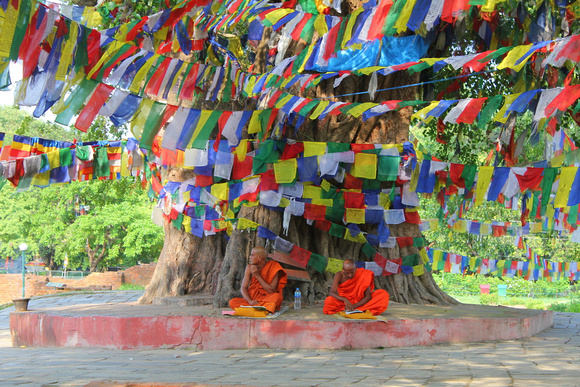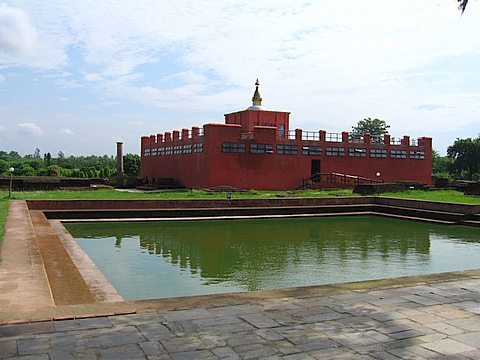Maya Devi Temple in Lumbini Nepal is the beautiful Maya Devi Temple dedicated to and named for the mother of the Lord Gautama Buddha. This is one of the four most divine places in all of Buddhism, as it is the site of his birth. The other sites are: Bodhgaya where he attained enlightenment under the sacred bodhi tree; Sarnath where he gave his first sermon and teachings; and Kushinigar where his physical body died
Shrine’s History
In the Buddhas time( 563 BCE) , Lumbini was a park situated in Kapilavastu Nepal. On a full moon night, Queen Maya who was married to King Suddhodhana (ruler of Kapilavastu) had a dream. She felt herself being carried away by four spirits to Lake Anotatta in the Himalayas. After taking a cleansing bath in the lake, the spirits dressed her and anointed her with perfumes and flowers. Following this, a white elephant holding a white lotus flower in its trunk appeared and went around her three times. Finally, it entered into her womb through her right side. Maya had a ten-month pregnancy and returned to her home for the birth. On the way there she stopped by a Sal tree in the beautiful flower garden of Lumbini Park. As Maya Devi enjoyed the park she chose to bathe in the puskarini pond in the garden to cleanse herself. After which she gave birth while standing and holding onto a branch from a Sal tree. Legend says that Maya gave birth to Prince Siddhartha from her right side on the eighth day of April. The bas relief above [ click to view ] depicts Maya Devi with her right hand holding on to a branch of a sal tree with a newborn child standing upright on a lotus petal, shedding an oval halo, around his head, while two celestial figures pour water and lotuses from vessels of heaven as indicated by the delineation of clouds. This nativity scene was installed by Malla Kings of the Naga dynasty from about the 11th to 15th Century in the Karnali zone of Nepal. In 249 BC, when the Emperor Ashoka visited Lumbini it was a flourishing village. Ashoka constructed four stupas and a stone pillar with a figure of a horse on top. The stone pillar bears an inscription which, in English translation, runs as follows: “King Piyadasi (Ashoka), beloved of devas, in the 20 years of the coronation, himself made a royal visit, Buddha Sakyamuni having been born here, a stone railing was built and a stone pillar erected to the Bhagavan having been born here, Lumbini village was taxed reduced and entitled to the eight part (only)”.


Architectural Relevance of This Shrine
avations at the Maya Devi Temple show that it also sits above the foundations of many other temples and stupas (sacred mound like structures said to contain relics of the Buddha). At least one of these is said to be a stupa erected by the great Emperor Ashoka who wandered about the hills in this region three centuries after Buddha’s birth. Another of the attractions of this Lumbini temple is the Pillar of Ashoka, which is the primary artifact discovered by the German archeologist Alois Furher in 1895. Before that time, the Lumbini Temple had remained lost to civilization for almost one thousand years. Inside the Maya Devi Temple are other ancient ruins, including sandstone sculptures carved with scenes from the Buddha’s birth. Next to this temple is a sacred pool where Maya Devi is said to have bathed before the birth. The newborn Buddha also reputedly had his purification bath in this pool. The pool is fed by the Ol River, and it was on the banks of the river that Furher found what he called a “flawless stone” placed there by Ashoka to mark the exact spot of the birth. The stone is now under the current temple, and a sacred bodhi tree grows next to the pool. Lumbini means “the lovely” in the Sanskrit language, and this temple in Lumbini Nepal is truly lovely in a very simple way, as is the custom in most Buddhist architecture. Reflected in the serene sacred pool is the reflection of the simple building made of red sandstone with portions painted red. As Buddhism is such a part of the fabric of everyday life in this region, visitors are seen everywhere sitting and standing in quiet meditation while children alternately run about in play and mimic the attitude of their elders. Prayer flags flap in the breeze, as offerings are made at the pillar

Shrine’s Map Location and How to Go There
By Road
This is the cheaper and more frequent route to Lumbini. From Kathmandu it’s 6-9 hours, 700-800 rupees. From Pokhara it’s 6-9 hours, 700-800 rupees. From Chitwan/Sauraha it’s 5-6 hours, 500 rupees. From any of those starting destinations you can take a bus to either Bhairahawa or the border town of Sunauli (getting off in Bhairahawa which the bus passes through). From Bhairahawa take a bus, taxi or rickshaw to Lumbini. Bus stops to Lumbini in Bhairahawa are not marked out so the easiest thing to do is simply ask a local where the next bus to Lumbini is. Generally speaking though buses drop people at the T junction in Bhariahawa so buses in either direction will be found on one of those roads. Buses do leave frequently, are large old style buses and cost about 10-15 rupees for the 20-30 minute journey to Lumbini. Do tell the driver you want to get off at Lumbini Bazar! As Lumbini is close to the border town of Sunali if you are coming up from India to visit Nepal it makes sense to stop over in Lumbini rather than travel all the way to Kathmandu and back.
By Air
Fly to Bhairahawa from Kathmandu then take a bus, taxi or rickshaw to Lumbini which is about 30 minutes away. Airfares vary but for foreigners it’s usually between $180-220 one way.
Extra Information About this Shrine
The focal point for pilgrims is a sandstone carving of the birth of the Buddha, reputedly left here by the Malla king, Ripu Malla, in the 14th century, when Maya Devi was worshipped as an incarnation of the Hindu mother goddess. The carving has been worn almost flat by centuries of veneration, but you can just discern the shape of Maya Devi grasping a tree branch and giving birth to the Buddha, with Indra and Brahma looking on. Directly beneath this is a marker stone encased within bulletproof glass, which pinpoints the spot where the Buddha was born. The sacred pond beside the temple is believed to be where Maya Devi bathed before giving birth to the Buddha. Dotted around the grounds are the ruined foundations of a number of brick stupas and monasteries dating from the 2nd century BC to the 9th century AD






































